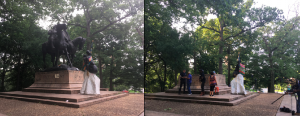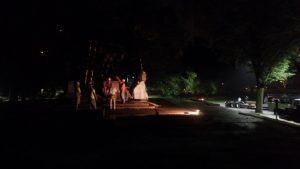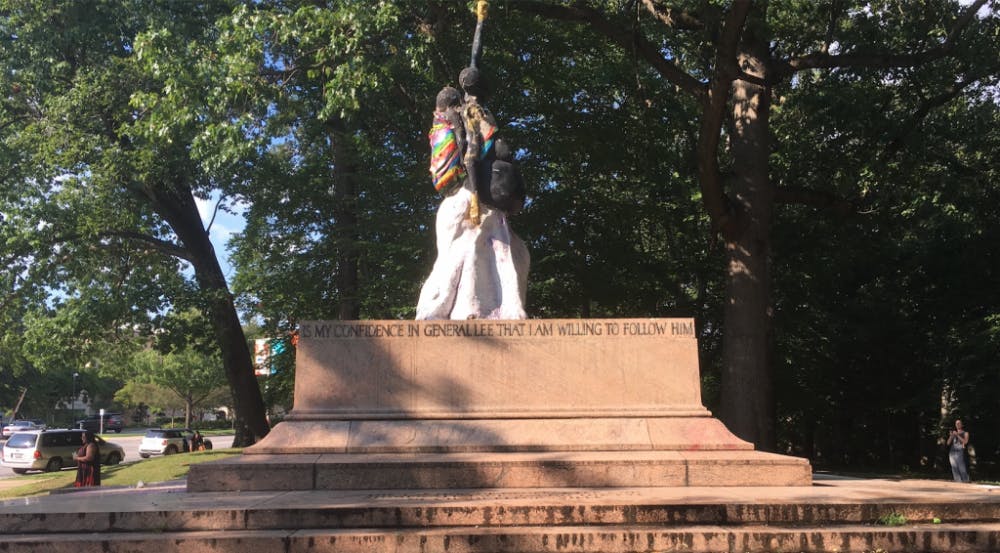After a protest against white supremacy in Charles Village on Sunday, the City of Baltimore took down its four Confederate statues late Tuesday night and early Wednesday morning. Mayor Catherine Pugh ordered the removal following Monday’s unanimous City Council resolution in favor of the action.
Baltimore has considered removing the monuments since 2015 but did not reach a decision until this week, following a white nationalist rally in Charlottesville, Va. on Friday and Saturday. At the demonstration on Sunday, Baltimore activists vowed to take the statues down if the city failed to act. During a press conference on Wednesday, Pugh said that she wanted to protect Baltimore citizens from potential violence.
“I spoke with the council on Monday morning. I said that with the climate of this nation, I think it’s very important that we move quickly and quietly,” she said.
Last weekend, white nationalist groups gathered in Charlottesville to protest the city’s plans to remove Confederate statues, including a monument of Confederate General Robert E. Lee. The demonstrators violently clashed with counter-protesters, leading to at least one death and multiple injuries.
Though Pugh acknowledged potential backlash from groups opposed to the removal, she defended her decision.
“What I know is that I did what’s right for my city,” Pugh said.

Kwame Alston, a senior and the president of the Black Student Union (BSU), stressed that removing these monuments is a symbolic victory.
“You can take down statues that represent white supremacy, but we still have white supremacy in our laws and systems of government,” he said.
Alston also said that while removing Confederate monuments is commendable, the city needs to do more to address its systemic problems with regard to Baltimore’s policing, infrastructure and housing.
The city removed the statue of Robert E. Lee and Thomas J. “Stonewall” Jackson in Wyman Park Dell and the Confederate Women’s Monument in Bishop Square Park, both of which are near the Homewood Campus. The Confederate Soldiers and Sailors Monument in Bolton Hill and the Roger B. Taney Monument in Mount Vernon were also taken down.
Originally, alongside the Lee-Jackson monument, there was a small plaque that was meant to contextualize the racist legacy the figures represented. According to that plaque, this monument was built in 1948 and was originally meant to portray the two Confederate generals as honorable “Christian soldiers.” The plaque also stated that the monument was built to “perpetuate the beliefs of white supremacy” during a time of racial intimidation and segregation. This plaque was removed when the monument was pulled down Tuesday night.
Crews removed the four monuments between 11:30 p.m. Tuesday night and 5:30 a.m. Wednesday morning, according to The Baltimore Sun. Since then, activists have placed the sculpture Madre Luz on the pedestal where the Lee-Jackson monument previously stood. This sculpture portrays a pregnant black mother with her fist raised. Artist Pablo Machioli and activist Owen Silverman Andrews, the sculpture's creators, originally placed it near the Lee-Jackson statue during the Sunday night demonstration.
Following the city’s actions, University President Ronald J. Daniels issued a statement on Wednesday.
“I commend Mayor Catherine Pugh and the City Council for their decision to remove Confederate monuments,” Daniels wrote. “We all witnessed the events in Charlottesville, Virginia, over the weekend, where such statues continue to be rallying points for white supremacists’ racism, and, ultimately, violence.”

Senior Jordan Britton was driving down 29th Street late Tuesday night when he noticed police cars near Wyman Park Dell. At first, he thought that protesters might be taking down the Lee-Jackson monument, but after pulling over, he realized that the removal was a city-led initiative.
“I hope the city replaces the statues with monuments that celebrate the resistance to white supremacy that [people of color] have put forth for the last few hundred years,” he wrote in an email to The News-Letter.
Though Britton agrees with the decision to take down the statues, he has mixed feelings about the effects of their removal.
“The monuments might be gone but white supremacy isn't,” he wrote.
Lester Spence, an associate professor and co-director for the Center for Africana Studies, hopes that the monuments’ removal will spark concrete action. He recommended that the city not destroy the bases on which the statues once stood.
“The Confederacy was a racist, white supremacist project, and to just erase these monuments as if they never existed would mean to erase that moment in history,” he said. “I can’t speak on what they should do with the statues that aren’t there, but I’m really hoping they keep the bases.”
Junior Matthias Gompers, a Baltimore County native, said that in light of the events in Charlottesville, the city of Baltimore made the right decision to remove the monuments. Although he understands why Pugh took action quickly and quietly, he thinks that an announcement should have been made.
Gompers rejected the idea that taking down the monuments erases history, and he suggested that they be relocated to Civil War museums.
“You don’t need a statue to study history. We have museums dedicated to the Civil War,” he said. “Baltimore of all places isn’t going to forget that the Civil War happened.”
Student Government Association (SGA) Executive Vice President AJ Tsang applauded Mayor Pugh’s decision to remove the monuments. He believes that the statues should be destroyed rather than preserved and displayed in a museum.
Tsang also worries about how some students who opposed removing the statues may react, but stressed that he is committed to ensuring that the events in Charlottesville never happen at Hopkins.
“To avoid violence, we really need to ensure that we avoid the presence of any white supremacists or white supremacist demonstrations on campus,” he said.
Despite the violence in Charlottesville, Tsang believes that the events of the past few days will bring the Hopkins community closer together. He noted the outpouring of support on social media following the removal of the statues.
“The fact that people banded together so quickly… shows that the Hopkins community is coming together in solidarity,” Tsang said. “Students, faculty and staff — I think we all rallied together to say that that statues needed to go.”
Alyssa Wooden contributed to reporting.





